Table of contents
- Honda CB 1000 R, KTM 690 Duke R, Suzuki GSX-R 750 and Yamaha MT-09 in the test Crossover comparison
- KTM 690 Duke R: aggressive single from Austria
- Yamaha MT-09: fiery drilling meets soft suspension
- Suzuki GSX-R 750: lonely avenger of her kind
- Honda CB 1000 R: Big block with star qualities
- What do we learn from this comparison?
- Measured values and test procedures
- acceleration
- Data recording
- route
- Conclusion
- 1. Suzuki GSX-R 750
- 2. Honda CB 1000 R
- 3. KTM 690 Duke R
- 4. Yamaha MT-09
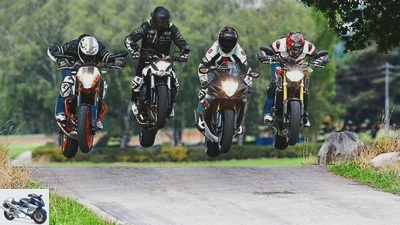
fact
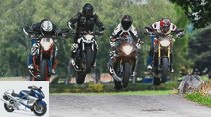
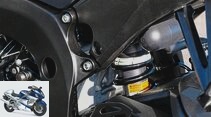
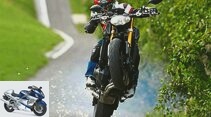

23 pictures
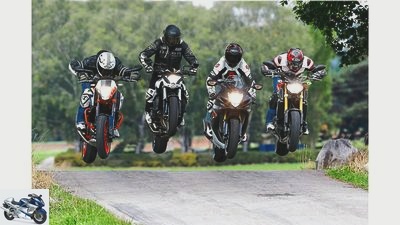
fact
1/23
Forget game consoles! The real action takes place on the diverse country roads of the republic. In this crossover test, four candidates face a particular challenge.
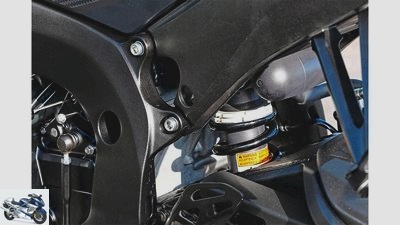
fact
2/23
The shock absorber, which can be set separately for high and low-speed compression, is tightly tuned and is generally somewhat insensitive.
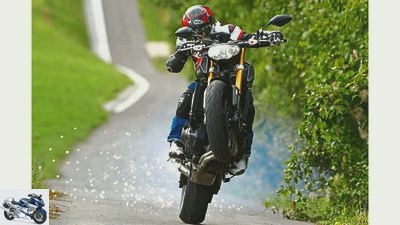
fact
3/23
Yamaha MT-09.
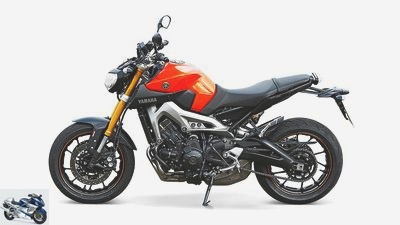
fact
4/23
Yamaha MT-09.
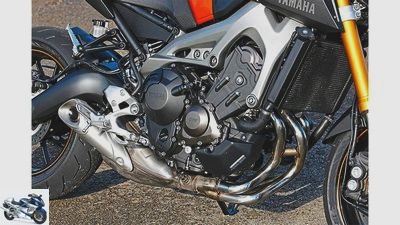
fact
5/23
The icing on the cake of the MT-09 is its wonderful three-cylinder. Already just above idling speed it generates great punch and is very easy to turn.
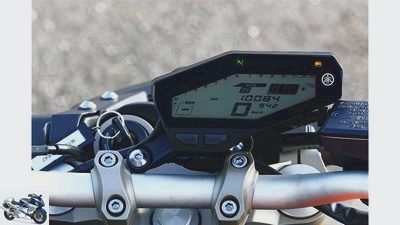
fact
6/23
The Yamaha cockpit is small but nice and provides all the important information including the fuel level and gear indicator. It even knows the outside temperature.
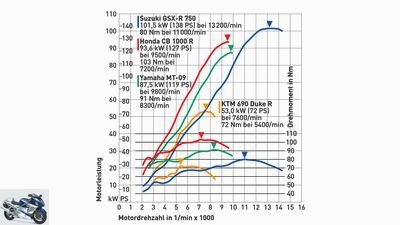
PS
7/23
Measurement diagram: power on the crankshaft, measurements on Dynojet roller test bench 250.
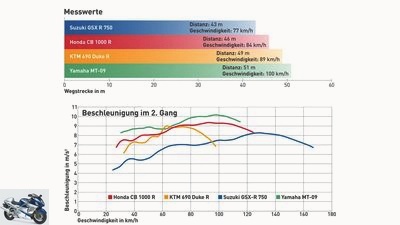
PS
8/23
The bar graph above shows a specific exercise. On a straight uphill section, we accelerated the bikes in second gear at 30 km / h for 3.5 seconds. This insert illustrates the dynamics experienced in practice with which the bikes fire off at low speeds – for example from tight corners.
The acceleration diagram below (theoretical values) takes into account not only the power but also the overall gear ratio and the weight of the machines. Far behind in terms of pure engine power, the KTM bravely keeps up with the leaders due to its low weight when accelerating, at least in the lower gears.

PS
9/23
Data recording: The recordings compare the fastest machine (Suzuki GSX-R 750) with the slowest (KTM 690 Duke R). Points one to three mark the maximum speeds at the fastest points on the course before the braking points. The points correspond to those on the route sketch (next picture). Noticeable: The Duke bravely keeps up to a maximum of 120 km / h, but then has to be demolished.
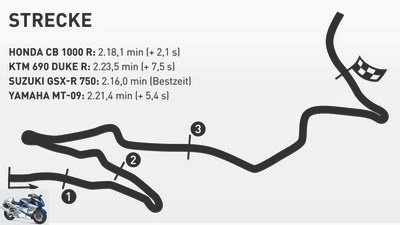
PS
10/23
The almost 3.9 kilometer long measuring section leads uphill and offers switchbacks, long arcs and alternating curves. It is representative of those country roads that we motorcyclists love so much.
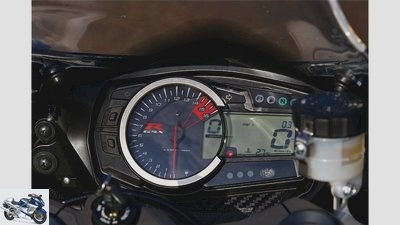
fact
11/23
Typical super athletes: the red area only begins beyond good and bad. The actual maximum speed is 14,500 rpm.
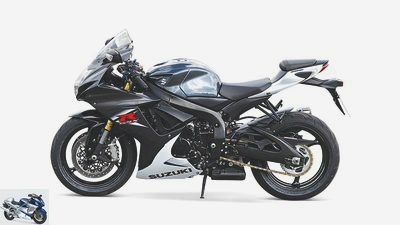
fact
12/23
Suzuki GSX-R 750.
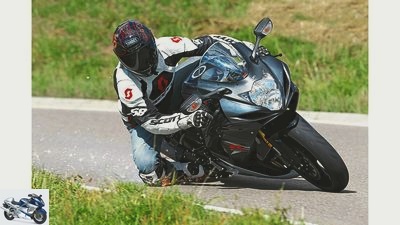
fact
13/23
Suzuki GSX-R 750.

fact
14/23
Also included are the KTM 690 Duke R, Suzuki GSX-R 750, Yamaha MT-09 and Honda CB 1000 R..

fact
15/23
Honda CB 1000 R..

fact
16/23
Honda CB 1000 R..
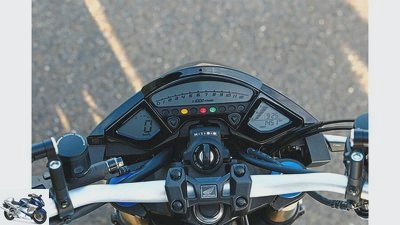
fact
17/23
This is what the future looked like in 2008: cockpit styling à la Honda. For today’s conditions it offers a rather sparse equipment.
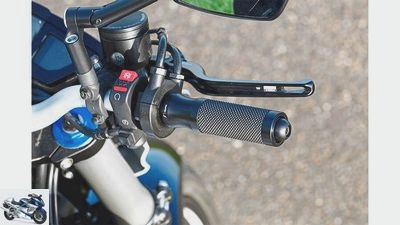
fact
18/23
The handlebar grips offer little grip and are part of the Rizom edition. Other features: mirrors, indicators, license plate holders, brake and clutch levers and their fluid reservoirs, etc..
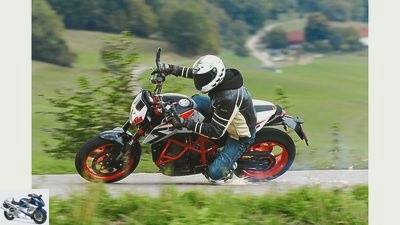
fact
19/23
KTM 690 Duke R..
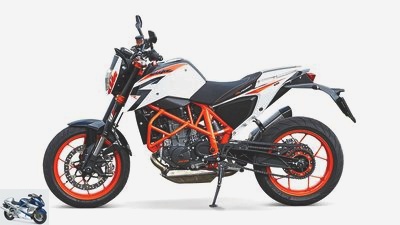
fact
20/23
KTM 690 Duke R..
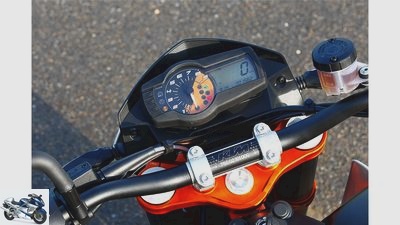
fact
21/23
Spartan information center without fuel level but with gear indicator. Hybrid cockpit with analog tachometer and mouse cinema.
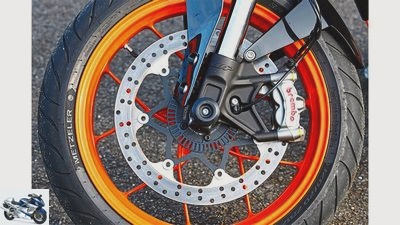
fact
22/23
The single-disc brake grabs a lot and is great to dose. A second disc is not necessary. The ABS, which can be switched off, could regulate a little later in attack mode.
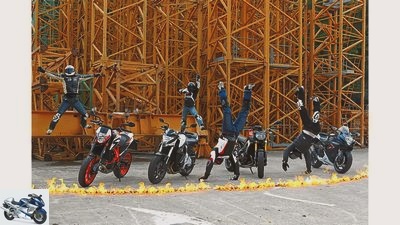
fact
23/23
Where there is smoke, there is fire. The four bikes offer many reasons to let off steam.
motorcycles
Honda CB 1000 R, KTM 690 Duke R, Suzuki GSX-R 750 and Yamaha MT-09 in the test
Honda CB 1000 R, KTM 690 Duke R, Suzuki GSX-R 750 and Yamaha MT-09 in the test
Crossover comparison
Content of
The action takes place on country roads with the Honda CB 1000 R, KTM 690 Duke R, Suzuki GSX-R 750 and Yamaha MT-09 – in this crossover test.
Volkmar Jacob
13/10/2015
The motorcycling people have always quarreled with the question of whether sporty single-cylinder cylinders draw circles around heavier and stronger opponents in close quarters. This is undoubtedly the case on karting tracks. But does such a concept also stand out outside of these special courses? And how do completely different genres do in real life? To answer these questions, we beat four different bikes over a varied, lonely and secret mountain route. On board: incorruptible data recording. The system relentlessly reveals the candidates’ strengths and weaknesses. Competing for the infight: Honda CB 1000 R, popular and proven nude in the one-liter displacement league, here as a limited and noble “Rizoma Edition”; KTM 690 Duke R, the hot version of the lively single-cylinder classic; Suzuki GSX-R 750, lightning-fast representative of the supersport category, and, last but not least, Yamaha’s MT-09, the best seller from Iwata with an exciting three-cylinder. Sorted nicely according to the number of cylinders, the Duke makes the start.
Buy complete article
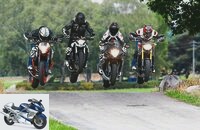
Honda CB 1000 R, KTM 690 Duke R, Suzuki GSX-R 750 and Yamaha MT-09 in the test
Crossover comparison
12 pages) as PDF
€ 2.00
Buy now
KTM 690 Duke R: aggressive single from Austria
The promises particularly in tight bends and fast alternating curves KTM 690 Duke R. an unassailable lead, which means that she wants to show off her taillight to the competition on the straights as well. Standing start, the flag is raised, let’s go! The coupling requires only minimal manual force and impresses with a superb grinding point. Splendid! Spurs from a standing start are child’s play.
The KTM takes the first long arc 690 Duke R full, the recordings attest her there real 143 km / h. At the second, somewhat narrower bend, briefly from the gas, then heavy anchoring in front of a 180-degree left. Wow, the single-disc system bites mercilessly and can be dosed first-class. The Duke does not need a second disc and saddle. Especially since the R version only allows solo operation. Only the ABS (which can be switched off) could intervene a tad later on the last groove.
The tightly tuned KTM 690 Duke R turns the hairpin with incredible precision. Accuracy and feedback are absolute madness. In the further course of the curve, however, it seems a bit nervous and constantly requires slight steering corrections. A characteristic that it exhibits all along the route in corners at different speeds. Tire thing? Unlikely. The Metzeler M7 RR need a certain warm-up time on the Duke because the lightweight exerts little pressure on the rubbers. But as in our case, they were really warm, and they impress with their impeccable handling. Possibly the low nervousness arises because of the high center of gravity in connection with the wide handlebars and the long suspension travel – all alleged troublemakers. However, it would not be fair to twist her into a rope. First of all, the corrections are kept within narrow limits. And secondly, the Duke compensates with handling from another planet. A slight impulse is enough, bang, and like Marvel’s comic book characters, she’s speeding through the streets.
Its engine works just as lively. From 3000 tours the huge single starts bravely with 690 cubic meters and delivers usable performance. But in hunting mode it requires speeds between 5500 and 7000 rpm. Only there does the stew generate maximum propulsion. At the same time, the fat 102 piston stomps up and down and delivers a unique single-cylinder beat – an expression of the purest zest for action! In more moderate use, such as in city traffic, the single cylinder is annoying below 3000 rpm with unpleasant heels and jerks. Avoid these speeds! And because we’re at Mosern: If you don’t shift properly, you often end up in a nasty intermediate idle between fourth and fifth gear. Throttle response and load changes, on the other hand, are top notch.
The bottom line is that the single with 72 measured horsepower is an extremely strong representative of his now rare guild. Only on the longer straight passages does he run out of breath a little. The KTM 690 Duke R covers the almost 3.9 kilometer route in 2.23.5 minutes. It can be strong but underdamped Yamaha MT-09 evaporate this time?
Yamaha MT-09: fiery drilling meets soft suspension
The Yamaha MT-09 pushes with noticeably more punch. It owes this to its much higher torque, which it draws from a proud 847 cubic capacity. In addition, with real 119 hp at 192 kilograms, it achieves a power-to-weight ratio of 0.62 hp / kilo. For comparison: the KTM 690 Duke R only creates 0.44 hp per kilo. This is particularly noticeable on the faster sections of the route, where the extremely lively and pleasantly cultivated three-of-a-kind hits. What a gem! The only criticism is the hard throttle response in driving modes “A” and “Std”. Since the factory started offering a modified mapping at the end of last year, we have already tested one or the other MT-09 with gentler load changes. Hello Yamaha: Did you forget to put the mapping on this bike??
The Yamaha MT-09 plows through the first curve with 155 things and thus 12 km / h faster than the KTM 690 Duke R. At the fastest point of the special route it is 170 to 150 km / h. That brings meters. At the first braking point, however, a moment of shock. The Yamaha’s ABS, which cannot be switched off, regulates even earlier than the Austrian’s system and surprises with rough intervals. Wide-eyed and stuttering brakes, the pilot shoots toward the hairpin. Now the rule is: keep your hands full and keep the original line! In addition, only brake at the front. Experience shows that the rear wheel ABS when anchored in the last groove on most bikes also affects the control behavior of the front stoppers. Avoiding the rear brake very likely prevented the trip off-screen in this case as well. For the other turns, however, earlier anchor throwing is on the program.
The usual picture emerges when you bend it. With slightly indifferent steering behavior and diffuse feedback, the pilot feels his way to the ideal line on the very comfortably tuned Yamaha MT-09. In addition, he sits quite inactive because of the high and close handlebars and the comparatively far forward mounted footrests. Although the MT-09 follows the steering commands of its pilot obediently, precise and stable is different. The setting is hardly advantageous even on the worst of surfaces, as the load takes off more often because of the underdamped rebound stage. And despite the soft design, the MT-09 tends to kickback the most in the test field. Our wish to Yamaha: Please finally give the bike a better chassis! Despite its shortcomings, the Yamaha MT-09 poured the KTM 690 Duke R into exactly 2.1 seconds with a time of 2.21.4 minutes. The record?
Suzuki GSX-R 750: lonely avenger of her kind
Next up is the Suzuki GSX-R 750 in the starting blocks. Measured 138 PS, 195 kilos combat weight, stiff chassis: the super sports car is a clear contender for victory. The wild Suzi underlines her ambitions with an aggressive suction rattle and a hoarse exhaust sound. Sit up. The Gixxe places its pilot lower and thus closer to the action than the competition – a wonderfully direct feeling.
Fire at ease, hold on! The Suzuki GSX-R 750 sprints energetically. Up to 100 km / h it takes just 3.2 seconds, until 150 things are 5.2. These driving dynamics create a thieving grin under the helmet and secure lonely speed records for the GSX-R in front of the braking zones. At the fastest point, the data recording certifies a breathtaking 184 km / h. As a reminder: the Yamaha manages 170 km / h there, the KTM 150 km / h. Even the Honda, so much in advance, “only” comes up with 172 things. For this performance, however, the 750 needs to be turned properly, preferably with five digits. What gives friends of the highest speeds the finest listening pleasure, is on the clock for others. The solution: take it easy in densely populated areas.
Enough of the warning words, let’s rather enjoy the great chassis of the super sports car. The shock absorber responds insensitively on bumpy ground despite the high-speed compression stage being completely open. The great big piston fork does that a lot better. But on our flat course, the stiff rear does not matter, on the contrary. The Suzuki GSX-R 750 hits the turn-in points with millimeter precision, circles exactly on the specified line and provides great feedback. That’s how we love it! Less pleasant: As before, Suzuki does not offer ABS for the 750 series, which was last facelifted in 2011. That is no longer appropriate. However, we don’t miss the system for this special treat. Anyone who always attacks with high concentration and in ideal conditions can do well without ABS. Especially since the stoppers can be dosed to work with a firm bite. Basically, however, ABS reassures even experienced pilots and prevents worse things from happening in the event of panic braking.
What time did the Suzuki GSX-R 750 burn in the asphalt? In a dreamlike 2.16.0 minutes she distanced the little Duke by a whopping 7.5 seconds, and burned the Yamaha 5.4 seconds. How do these huge differences come about? The Measured values page provides information.
Honda CB 1000 R: Big block with star qualities
Intimidated by the Suzuki template, the Honda rolls CB 1000 R at the start. Your advantage: With 103 Nm from the full liter displacement, it provides the highest torque in the test field. That should give her advantages out of the corners. In addition, the in-line four-cylinder with 127 hp stands well in the forage. The crisp, short overall ratio and the perfectly shiftable gearbox play the Honda in the cards.
But as hard as she tries, the recordings show a clear picture: the Suzuki GSX-R 750 slowly pulls away. The 220 kilos of the naked bike are too heavy, the difference in performance is too great. The fact that the Honda CB 1000 R hammered the second fastest time with 2.18.1 minutes and only lost a little more than two seconds on the GSX-R proves its great potential. It pulls its course confidently and stably, shows itself unimpressed by tricky passages and has no peculiarities. “Yawning boring!” Blaspheme their opponents. “Well-balanced and mature,” exult the proponents. The relaxed but active seating position suits her convincing performance. The CB 1000 R is a real Honda in the best sense of the word.
However, it cannot hide its mass. The Honda CB 1000 R would like to be asked into the corners with a little emphasis. It also stands up most clearly when braking in an inclined position. A consequence of the aged Bridgestone BT 15. On the plus side is the divinely late control ABS. The Honda masters braking points beyond good and evil without significantly increasing the pulse of the driver – perfect! In addition, it shines with perfectly coordinated and finely appealing spring elements. The naked woman hovers calmly over the worst of the ground: asphalt wrinkles – what is it?
What do we learn from this comparison?
1. At a brisk pace, performance is always an issue.
2. With a similar performance, the chassis makes the difference.
3. Light and lively bikes only have a chance if the speed limit is strictly adhered to or in the tightest of terrain. And this terrain hardly exists in the wild. But most of all it depends on the pilot. Fast drivers on inferior machines effortlessly iron the average talent on their high-horsepower rockets. In individual cases, the assertion is certainly true that stews drive circles around muscle-bound calibers. Basically, however, it is not right. No way!
Measured values and test procedures
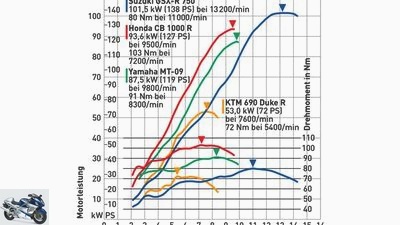
PS
Performance chart
The usual diagram shows the (calculated) power on the crankshaft. The largest cubic capacities – Honda CB 1000 R and Yamaha MT-09 – develop their power already at comparatively low speeds, which you can clearly feel when driving. The fact that even the Duke always punches more powerfully than the Suzuki GSX-R 750 up to its peak of performance is due to the characteristics of the Japanese four-cylinder, which is designed for high speeds and maximum peak performance.
acceleration
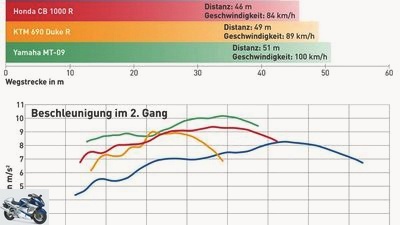
PS
Bar graph and acceleration diagram
The bar graph on the left shows a special exercise. On a straight uphill section, we accelerated the bikes in second gear at 30 km / h for 3.5 seconds. This insert illustrates the dynamics experienced in practice with which the bikes fire off at low speeds – for example from tight corners. The front runner, the Yamaha MT-09, takes the super sporty Suzuki GSX-R 750 eight meters from the super-sporty Suzuki GSX-R 750 and is a whopping 23 km / h faster at 100 km / h. The Honda CB 1000 R and KTM 690 Duke R also distance the long-geared Suzuki, which is designed for high speeds.
The acceleration diagram (theoretical values) takes into account not only the power but also the overall gear ratio and the weight of the machines. Far behind in terms of pure engine power, the KTM 690 Duke R bravely keeps up with the top, at least in the lower gears, due to its low weight when accelerating.
Data recording
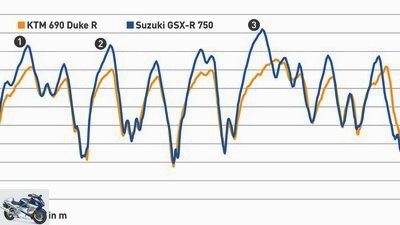
PS
Comparison of the fastest (Suzuki GSX-R 750) and the slowest machine (KTM 690 Duke R).
The records compare the fastest machine (Suzuki GSX-R 750) with the slowest (KTM 690 Duke R). Points one to three mark the maximum speeds at the fastest points on the course before the braking points. The points correspond to those on the route sketch (below). Noticeable: The Duke bravely keeps up to a maximum of 120 km / h, but then has to be demolished. The curves of the Yamaha MT-09 and Honda CB 1000 R are similar to those of the Suzuki, but have lower maximum values.
route
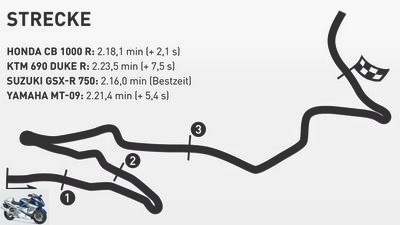
PS
The test and measurement track.
The almost 3.9 kilometers long, varied measuring route leads uphill and offers switchbacks, long arcs and alternating curves. It is representative of those country roads that we motorcyclists love so much. The start is standing, the end of the measurement after the acceleration phase from a hairpin.
Conclusion
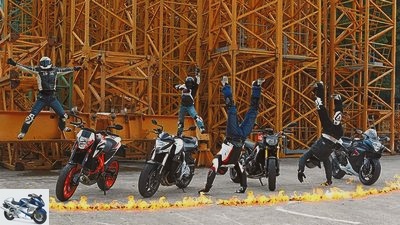
fact
Four bikes of different sizes and weights competed.
1. Suzuki GSX-R 750

fact
Suzuki GSX-R 750
The super sporty Suzuki GSX-R 750 makes the race. With her superior punch and the precise and tight chassis she does it well for the competition. However, the stucky shock absorber is annoying on bad roads. A real drawback, however, is the lack of ABS. Nowadays a reason to refuse. If you can do without this feature, you will find a potent playmate in the Suzi.
2. Honda CB 1000 R

fact
Honda CB 1000 R.
The Honda CB 1000 R lands in second place. Typical of the brand is the mature and well thought-out concept. The unexcited CB does not make any major blunders. Which proves: Despite her old age – after all, it has existed in its basic form since 2008 – the nude is still fully into music. Despite her pounds, she stays amazingly well on the fast Suzuki.
3. KTM 690 Duke R
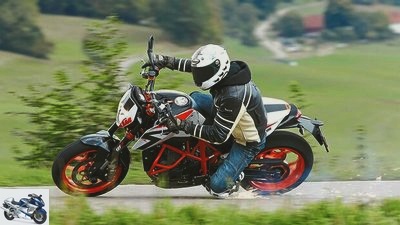
fact
KTM 690 Duke R.
Third place for the KTM 690 Duke R. Above-ground handling, great brakes, best feedback: the highlight of the sporty lightweight is clearly the chassis. In this chapter, she consequently wins the points. In the engine chapter, however, the fun car logically weakens a bit in direct comparison with the competition. In addition, the Duke R is quite expensive at around 10,000 euros. Clearly a bike for lovers.
4. Yamaha MT-09

fact
Yamaha MT-09
For the Yamaha MT-09 only the red lantern remains. On the engine side, the MT-09 pulls itself out of the affair again fabulously in this test, which brings you the most points in this chapter. Unfortunately, the softly coordinated spring elements, the poor ABS and the inactive sitting position make the protrusion behind. Please maintain the model!
Related articles
-
Comparison test: Honda CBF 1000 Silverline, Suzuki Bandit 1250 S, Yamaha FZ1 Fazer
Jahn 22nd pictures Honda 1/22 Honda CBF 1000 Honda 2/22 Honda CBF 1000 Zdrahal 3/22 Presentation at the fair in Paris. Honda 4/22 Honda CBF 1000 Honda…
-
Concept comparison: Honda Fireblade, KTM 990 Super Duke R, Suzuki GSX-R 600, Yamaha FZ6
Gargolov motorcycles Concept comparison: Honda Fireblade, KTM 990 Super Duke R, Suzuki GSX-R 600, Yamaha FZ6 Concept comparison: Honda Fireblade, KTM 990…
-
Comparison test Honda CBF 1000 F and Suzuki Bandit 1250 S
Bilski 32 pictures Bilski 1/32 The CBF 1000 F looks more elegant, dignified, sleeker. The 1250 Bandit comes across as beefier, more powerful with a more…
-
Comparison test Yamaha FZS 1000 Fazer-R1 and Honda Hornet S-CBR 600 F
Jahn motorcycles Super athlete Comparison test Yamaha FZS 1000 Fazer / R1 and Honda Hornet S / CBR 600 F Comparison test Yamaha FZS 1000 Fazer / R1 and…
-
Comparison test Ducati Monster 1200 S, Honda Fireblade, Kawasaki Z 1000 SX, Suzuki GSX-S 1000 F
jkuenstle.de 27 pictures jkuenstle.de 1/27 The disguised Suzuki GSX-S 1000 F has to prove itself in the field of competitors. jkuenstle.de 2/27 Nice is…
-
Comparison test Honda CBF 1000 against Suzuki Bandit 1250 S
Rossen Gargolov motorcycles Comparison test Honda CBF 1000 against Suzuki Bandit 1250 S Comparison test Honda CBF 1000 against Suzuki Bandit 1250 S We…
-
Honda Fireblade, Kawasaki Ninja ZX-10R, Suzuki GSX-R 1000, Yamaha YZF-R1
fact 28 pictures Honda 1/28 Honda 2/28 Honda 3/28 Honda 4/28 Honda 5/28 Honda 6/28 Honda 7/28 Honda 8/28 Honda 9/28 Honda 10/28 Honda 11/28 Honda 12/28…
-
Jahn 31 pictures Photos: fact / Jahn 1/31 Honda Fireblade, Kawasaki Ninja ZX-10R, Suzuki GSX-R 1000, Yamaha YZF-R1, Ducati 1198S, KTM 1190 RC8 R and…
-
Tuning and conversion guide Suzuki GSX-R 1000
Andreas Feulner 15th pictures Feulner 1/15 Performance and electronics – in these areas Suzuki has neglected the GSX-R 1000 badly. Nevertheless, it is…
-
Comparison test between Suzuki DL 1000 V-Strom and Yamaha TDM 900
Artist motorcycles Comparison test between Suzuki DL 1000 V-Strom and Yamaha TDM 900 Comparison test between Suzuki DL 1000 V-Strom and Yamaha TDM 900…